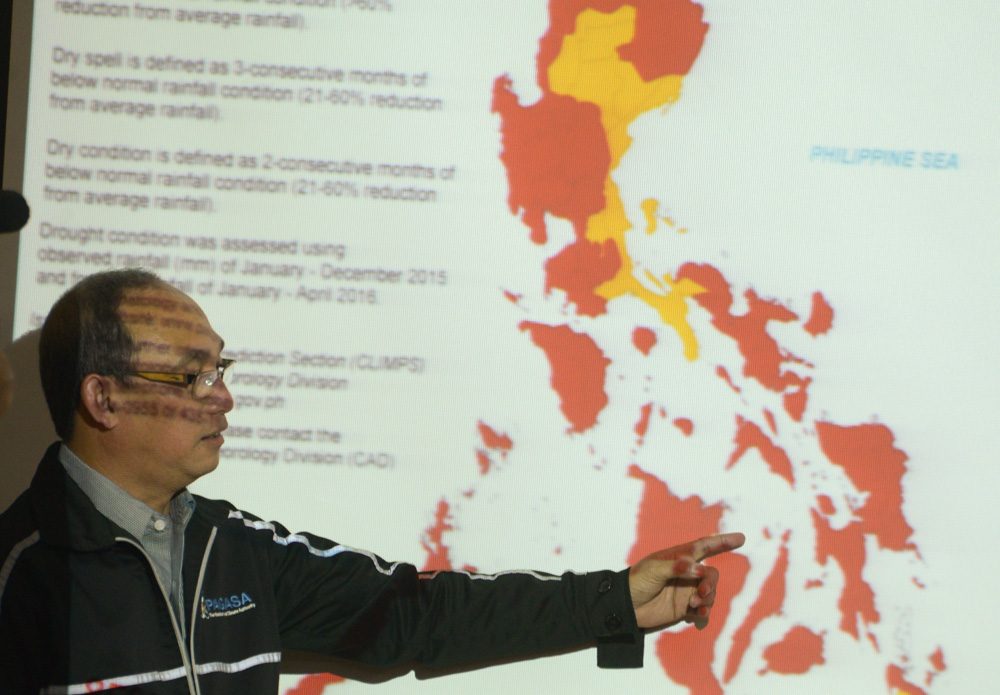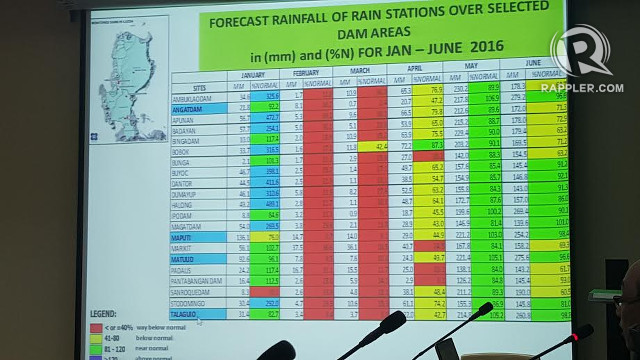SUMMARY
This is AI generated summarization, which may have errors. For context, always refer to the full article.


MANILA, Philippines – The strong El Niño that began in 2015 is likely to last until the first half of 2016, said Philippine climate forecasters on Wednesday, January 6.
The El Niño will be strongest during the months of February to April, according to the Philippine Atmospheric, Geophysical, and Astronomical Services Administration (PAGASA).
The phenomenon will affect the country’s water supply the most from February to March when it is expected to bring “way below normal” rainfall over the most important dams and lakes in the country.
PAGASA data show that 21 dams and 7 watershed areas will experience rainfall that is only 40% or below of the usual rainfall during these two months.

The effect on the country’s most important dams and watersheds will have an impact on water supply for both domestic use and for irrigation of agricultural lands.
In Mindanao, the power supply will be affected since Lake Lanao, its source of hydroelectricity, is one of the water sources that will suffer from below normal rainfall.
Other affected water sources are the Angat Dam and watershed, which supplies 90% of Metro Manila’s water. For Visayas, the critical Malinao watershed in Bohol will also have to cope with way below normal rain.
Here is the list of dams likely to experience 40% or below rainfall from February to March 2016:
- Ambuklao Dam
- Angat Dam
- Apunan Dam
- Badayan Dam
- Binga Dam
- Bobok
- Bunga
- Buyoc
- Dantor
- Dumayup
- Halong
- Ipo Dam
- Magat Dam
- Maputi
- Marikit
- Matulid
- Padalis
- Pantabangan Dam
- San Roque Dam
- Sto Domingo
- Talaguio
Here is the list of watersheds likely to experience 40% or below rainfall from February to March 2016:
- Angat Watershed
- Lake Buhi
- Lake Lanao
- Magat Watershed
- Malinao Watershed
- Pantabangan Watershed
- San Roque Cascade Watershed
P79 million for cloud seeding
To lessen the blow of El Niño, the government’s El Niño Task Force will conduct cloud-seeding operations throughout the next few months.
“We began cloud-seeding in December in Angat Dam. But the storms Nona and Onyok also helped replenish the water supply,” said Jun Dalida, PAGASA deputy administrator for operations and services.
The government has just approved the use of P79 million for cloud-seeding operations during the first half of 2016, he added.
After conducting one over Pantabangan Dam, another important water source in Luzon, operations will be conducted in Visayas and Mindanao.
Dalida gave assurances that cloud-seeding operations would be worth the expense. A bulk of the funds is spent on fuel for Air Force planes. Water concessionaire Maynilad is providing the salt for free.
Forecast of drought-affected provinces from January to June 2016:
Equipment help ensure clouds that are “seeded” will pour rain over the areas that need it the most.
“PAGASA uses state-of-the-art Doppler radar that can ‘X-ray’ clouds to check their liquid content, wind speed, and wind direction. This makes cloud-seeding more accurate,” Dalida said in a mix of English and Filipino.
Rain produced by cloud-seeding usually falls within 15 to 30 minutes after the operation, he added.
Drought, or a 3-month period of more than 60% reduction in rainfall from average amounts, will continue to grip parts of the country until June.
In January, 20% of the country (16 provinces) is likely to experience drought. But come April, 85% (68 provinces) will be affected.
The drought is expected to wind down starting June, although higher than normal summer temperatures can still be expected all over the country. – Rappler.com
Add a comment
How does this make you feel?
There are no comments yet. Add your comment to start the conversation.